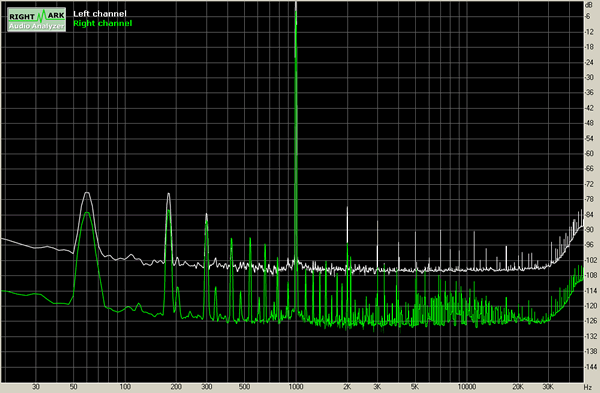The Proof of the Pudding

This is a plot of the spectrum from a 2VRMS 1kHz sine wave measured using an Audigy 2ZS soundcard and RMAA software in a noisy environment. The green plot is a straight wire loop from input to output. The white plot is the same but with the preamp interposed in the loop, and is transposed upward by 20dB for clarity. There are two striking things about these plots. First, the preamp, by virtue of the input transformer, actually improves matters. The straight wire loop has picked up all kinds of noise and distortion from the rather noisy test environment- this is greatly reduced by including the preamp in the loop. Second, where’s the distortion? It’s below the test residual (about 0.003%). And although the noise can be seen, at no point does it threaten to rise above the -100dB design target set out in the beginning. The 120Hz ripple is nowhere to be seen, and there is only the faintest trace of 60Hz hum pickup.
Although the op-amp’s offset voltage (often a bit worse for FET input compared with bipolar input) would seem to be a limitation, I was unable to measure any output offset from the preamp. Not bad. IM at 10kHz/11kHz was seen to be near residual, 0.005%. Swept IM was below test residual, 0.02%. THD checked at 20Hz and 20kHz was, within the uncertainty of measurement, identical to the 1kHz numbers.
The preamp works as advertised. Heresy has its virtues.
Acknowledgements
As usual, I tapped the brains of a lot of smart people. Steve Eddy put the transformer bug up my, errr, nose, and was kind enough to do the nice drawings and host them. Joel Tunnah’s schematic symbols made it easy for an old fart like me to draw the dodgier-looking schematics. John Curl lectured me at length about servos. Various individuals at diyAudio.com helped me fix my errors and improve the presentation; of special note was the input from Brian Beck. And finally, Morgan Jones was kind enough to look this over and make some pertinent suggestions; his repeated application of some excellent English ales to THIS author was an inspiration.
This is an expanded and edited version of an article that originally appeared in Bas Horneman’s excellent on-line publication, diyMag.

Probably amazing results.Way over my head but thank you for the line input transformer nod.I may investigate using that in a preamp I am trying to build using 6N6P tubes.